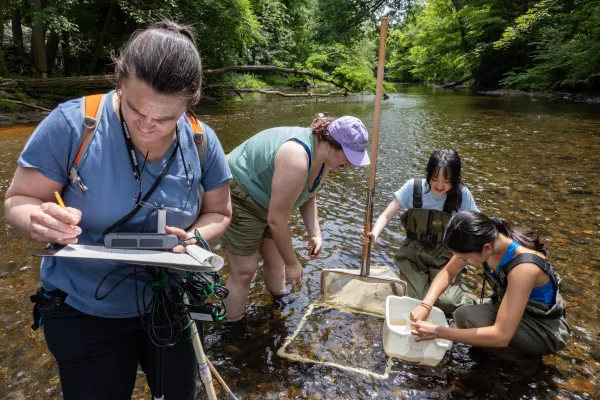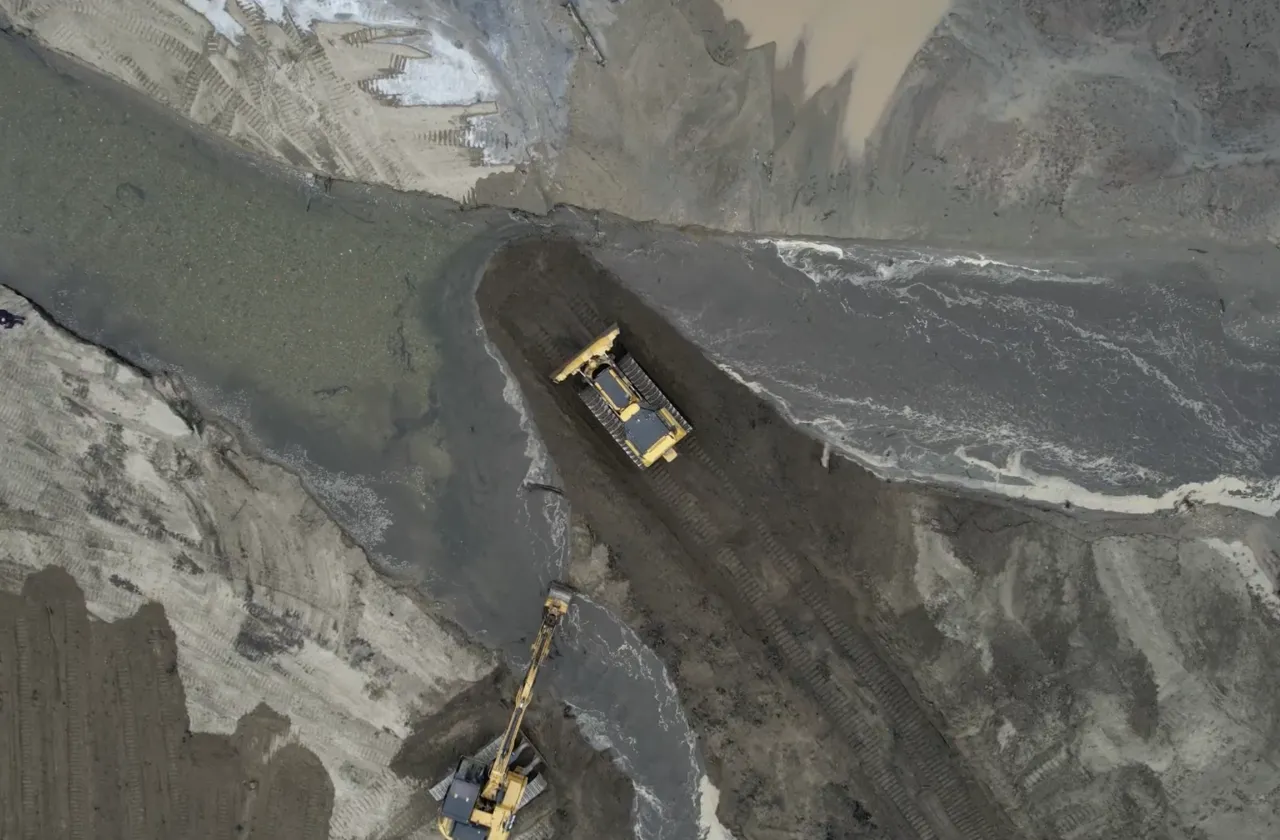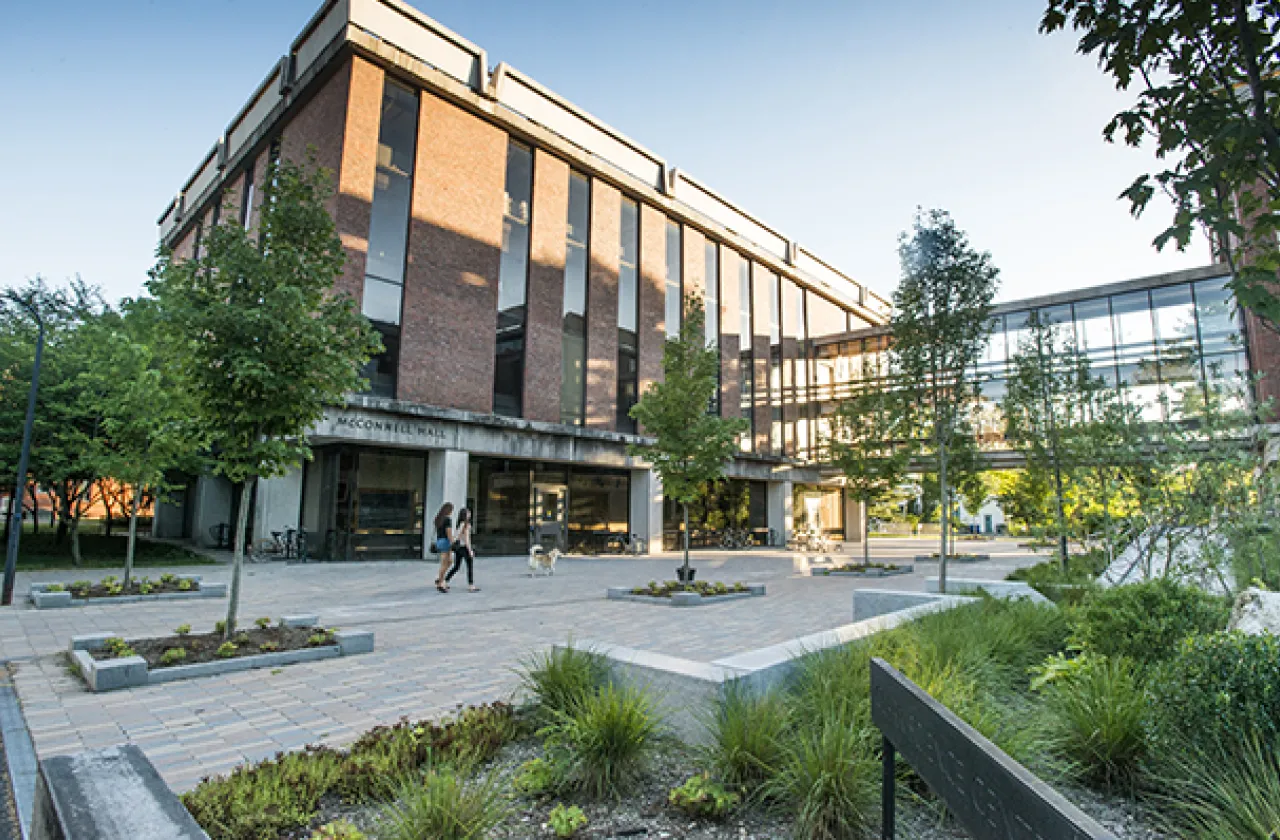No One Wants the Midges Record And Other Lessons From the River
Research & Inquiry
To understand Mill River water quality, students look at the smallest residents

Photo by Jessica Scranton
Published August 9, 2024
Lilian Olson ’25, Lya Rao ’26, and Sabrina Wang ’27 are standing in the middle of the Mill River on a sunny summer day, staring into the burbling current. “There’s lots of leaf litter over here,” says Olsen, hefting a stone. As the other two poke and scrape, Wang, in large green waders, settles onto a large rock and arranges an open net at her feet.
“Shuffle!” says Wang, and the trio bend down to riffle the river bottom with their hands, stirring up the silt to gather as many of the tiny creatures living there as they can. When you’re charged with counting the smallest residents of the river—and using them to determine water quality—every larval midge and mayfly matters.
The students, including others like Nicole Asselin AC and Cleo Waxman-Lee '27 working further down in the stream, are members of the Summer Undergraduate Research Fellowships program, which for the past 12 years has served as a centerpiece and cornerstone of the rich research collaboration between faculty and students.
They are also part of an ongoing effort, led by Professor Marney Pratt, to continually monitor the health of the section of Mill River that runs through Smith. That laborious process—coupled with a hefty dose of determination on Pratt’s part—has recently led to new insights into how the management of Paradise Pond, and climate change, could be affecting the local ecosystem.

To fully understand this complex environment, Pratt and her students have been gathering information since 2015. They have measured water flow and temperature, food availability, weather, and have laboriously counted the most numerous inhabitants, known as macroinvertebrates. The annual data is often so overwhelming that it has been hard to parse.
“Downstream and upstream are consistently different from each other,” notes Pratt. “What is different about the two environments? I couldn’t make any sense of it for the longest time.”
As an ecosystem bellwether, there are few animal groups more helpful than macroinvertebrates, a category that includes the aquatic larvae and nymphs of flying insects, worms, beetles, and mussels, among others. Since they are so sensitive—to weather, heat, turbidity—and serve as a living buffet for other animals, macroinvertebrate populations can act as an early warning system about the river’s health.
“They’re in the middle of the food chain,” Pratt noted. “They’re not right at the bottom, they’re not right at the top, so they’re a good link between a lot of different organisms.”


To understand these creatures, SURF students like Olsen, Wang, and Rao can be found all summer bent over microscopes in Sabin-Reed 223. The students listen to K-pop, J-pop, and ecology audio books as they take jars of ethanol-preserved samples, color coded by day and location, and meticulously separate the contents. First plant matter is discarded, then the tiny creatures are identified, counted, and sorted into petri dishes. To identify each organism in their samples, the students refer to a key (created by Pratt) that features images and descriptions of each genus.
“You have to be really patient and be detail-oriented. You have to have a good eye,” notes Olsen. “If there’s a bunch of caddisflies in there, even if I think they’re the same thing, I can’t just add 20 to whatever vial. I have to look at them and make sure they have the right characteristics.”
“There’s a lot of beauty in [Paradise Pond] that I guess I hadn’t really been paying attention to. When people think about biodiversity and protecting the environment and the climate, they’re not thinking about how important insects are.”
Using labor-intensive processes, the group was surprised to recently see an exponential jump in the number of organisms. Anticipating that the number of larvae for midges would not exceed their previous local record of 900 in a sample, Pratt was taken aback last year when one of her summer students counted over 10,000 at once. The number itself was impressive, but even more so considering that the tally involved students laboriously sorting and then examining each insect under microscopes—hour after hour and day after day—to reach that final count.
“Who wants the record of midges? No one,” said Pratt. “When you’re counting them, you’re like, ‘No more midges. Please, no more.’”

To get to the bottom of what was going on, Pratt had to first interpret the data in a new way. To employ the multivariable analysis she needed to understand the big picture, Pratt worked in her free time to slowly teach herself the coding language R, which her statistical models required, and then figure out how to accurately apply the code.
The college had recently switched from draining the pond and removing sediment in the summer to doing that work in the winter. Did that have something to do with the numbers Pratt and her students were seeing?
Pratt presented the results of this work this spring to a group of local experts and colleagues at the Paradise Pond Sediment Workshop, hosted at the college.
“When we dumped sediment in July, the amount of organisms went down really noticeably,” she said. In the winter, though, the data showed little negative impact and, in fact, certain organisms like winter stoneflies seemed to benefit.
The analysis also helped Pratt start tracking the extreme weather conditions and river discharge, both of which are likely driven by climate change, with an eye toward eventually understanding how those conditions affect organisms along the river’s path.

“What I see consistently is that there’s a difference between upstream and downstream in general, it’s just an overall impact of the pond,” said Pratt. “What we’re doing for sediment redistribution doesn’t seem to be adding that much on top of that, not in a way that it can’t recover from.”
Pratt noted that the impacts from the winter sediment redistribution tended to be small with any additional material quickly flushed away. Overall, the redistribution efforts might even have an upside, she said. “If anything, it’s adding more nutrients and benefiting some of the organisms.”
The study of these creatures has given the students a new perspective on the abundant life underfoot and under the stream. While to varying degrees Olsen, Rao, and Wang were slightly squeamish about working with insects, after a short time in the lab this summer, all three quickly developed favorites among the tiny creatures.
For Olsen, the best were the drunella mayfly larvae with their “chunky arms” that “look [like something from a] horror movie to me, but in a fun way.” For Rao, caddisflies started to “look cute.” Wang preferred the equally cute flatheaded mayflies. All three students agree that the best lesson from the SURF experience is a completely new appreciation for river inhabitants.
“There’s a lot of beauty in [Paradise Pond] that I guess I hadn’t really been paying attention to,” notes Olsen. “When people think about biodiversity and protecting the environment and the climate, they’re not thinking about how important insects are.”
As for the 2024 summer tally? Pratt reports that her five students found almost 23,000 organisms. 13,809 of them were midges.


